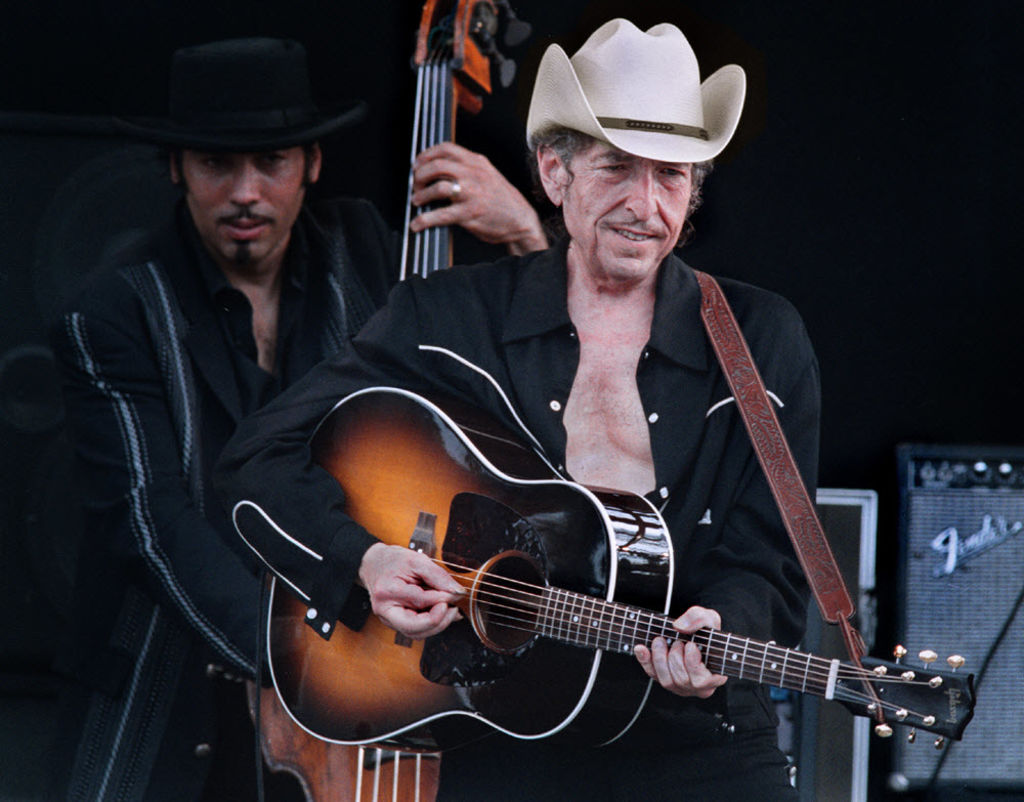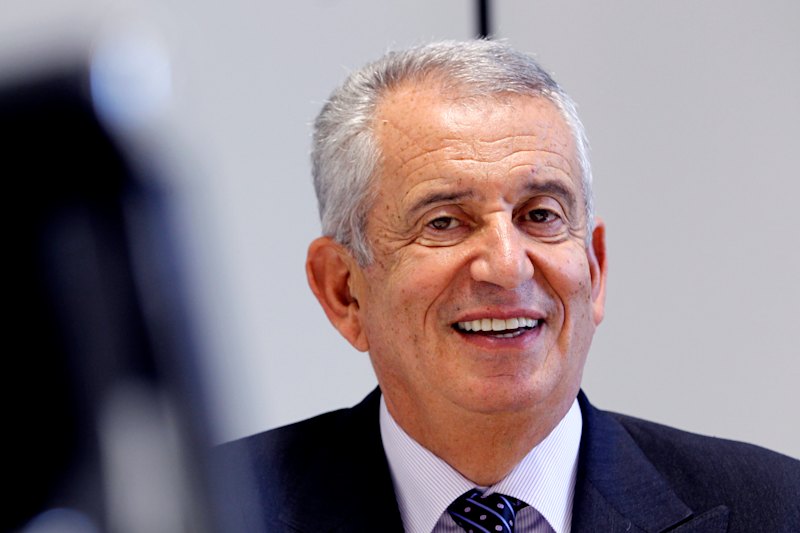
A billionaire's quirky quest to create a mecca for Bob Dylan fans - in Tulsa
Karen Heller
TULSA, Oklahoma: Robert Zimmerman was born in northern Minnesota, made a name for himself – specifically, Bob Dylan – in Greenwich Village and lives on a Malibu spread when not on perpetual tour.
Oklahoma barely figures in his life’s narrative or his work.
But the state’s second-largest city, brimming with art deco buildings from its glory days as the nation’s oil capital, is now the polestar of Dylanalia, home to a massive trove of artifacts related to the artist, plus 84,000 items (and growing) in a digital archive of audio, video, film and photography.
Curator Michael Chaiken pulls gems from the temperature-controlled archives at Tulsa’s art museum: a pristine leather jacket, packed in tissue like a grandmother’s wedding gown, that Dylan donned for his historic 1965 Newport Folk Festival appearance; the scarred, scratched and yellowed Turkish frame drum that sparked “Mr. Tambourine Man”; spiral pocket notebooks crammed – in microscopic, tidy schoolboy scrawl – with the seismic lyrics to “Blood on the Tracks.”
In an antiseptic reading room lined with long tables, Chaiken produces Dylan’s wallet from 1965, Otis Redding’s business card (Dylan wanted the soul singer to record “Just Like a Woman”; it didn’t happen), a piece of graph paper scribbled with Johnny Cash’s phone number (865-1550), a trio of harmonica holders (no Dylan costume is complete without one), a solitary acoustic guitar.
The collection of 6000 objects includes his written versions of many songs – 20 pages of lyrics for “Dignity” alone, versions of “Visions of Johanna” and “Like a Rolling Stone” (many lines excised, such as “all your frowns turned out to be just method actors all in drag”).
On a set of computers with a secure server, it’s possible to listen to take after studio take of “Tangled Up in Blue.”
It is a feast of Bob.
And a very big deal, for fans and for Tulsa.
Dylan, 76, the only musician to win the Nobel Prize for Literature, cautioned “don’t look back,” the title of D.A. Pennebaker’s 1965 documentary on the artist, yet his camp has assiduously guarded his writings and recordings so that other people will soon be able to.
“You don’t often get a Nobel Prize winner with this sort of breadth of a career, which makes this archive something special, like Graceland in Memphis,” says Rice University historian Douglas Brinkley, who is friends with the musician and has visited the archives.
Housed at the Helmerich Centre for American Research at the Gilcrease Museum, the collection will officially be made available to scholars and biographers this month; at least 200 have already filed requests for access.
The bulk of the material, much of it stored on those secure computer files, will remain at the museum. But many of the objects, plus audio and video highlights, will move to the planned Bob Dylan Centre in a former paper warehouse. The search for an architect is underway, and the centre is expected to open the public in 2019.
It can’t be soon enough for the singer’s legions of fans and chroniclers, many of whom border on the obsessive. The need to understand and document Dylan is apparently incessant, a crusade.
There are more than 1000 books about the artist, says associate archivist Mitch Blank, a noted collector of Dylanology, though “very, very few reveal very much.”
Author Clinton Heylin isn’t certain how many books he’s written on Dylan. “Let’s say a nice round dozen,” he says from his home in London.
“The thing about Dylan is he keeps changing. I’ve revised one Dylan biography three times,” Heylin says, then pauses. “I think I’ll have to revise it again.”
Dylanologists debate major events the way war buffs refer to battles: May 17, 1966, the “Judas” concert in Manchester, England. July 29, 1966, Dylan’s Triumph motorcycle accident in Woodstock, New York (a Friday, sunny).
“Dylan’s furtive,” says Princeton University historian Sean Wilentz, an adviser to the archive. “Yet you hear him every day. He’s miasmic. He’s everywhere.”
The arrival of the musician’s archive is bound to make this city of 400,000 a primary destination in Bob Land. Actually, it will make Tulsa a musical mecca. The city is already home to the Woody Guthrie Centre, a museum and archive devoted to the folk singer (and also housing the archive of protest singer Phil Ochs).
Tulsa isn’t finished.
The heirs of Johnny Cash, a frequent Dylan collaborator, are reportedly in discussions about basing the country music singer’s archives in Oklahoma as well.
All of which, says Brinkley, who is writing a book on Dylan’s 1970s recordings, “is going to make Tulsa the headquarters of Americana music.”
The Dylan collection is improbably located in this city of verdant hills on the banks of the Arkansas River largely because of two men: Guthrie and Tulsa billionaire George Kaiser, who is only a nominal Dylan admirer.
Guthrie was an Okie, albeit an ambivalent one, who fled nearby Okemah almost as soon as he could hop a freight train. Six years ago, the George Kaiser Family Foundation purchased the seminal folk singer’s archive for about $US3 million ($3.8 million) with the blessing of the singer’s daughter Nora.
The handsome Woody Guthrie Centre opened in 2013. When New York rare books and archives dealer Glenn Horowitz, who handled the Guthrie sale, was offered the Dylan collection, he emailed the Kaiser foundation’s executive director, Ken Levit, in the fall of 2014. He thought that Dylan’s material might be right at home down the street from the Guthrie collection; Bob back again near Woody, rather than buried in a university library stuffed with other important archives.
Dylan thought so, too. Though he rails against being worshipped himself, Dylan idolises Guthrie.
“Tore everything in his path to pieces. For me it was an epiphany, like some heavy anchor had just plunged into the waters of the harbour,” Dylan wrote of Guthrie in his memoir, “Chronicles: Volume One.” (Thirteen years later, there is no sign of Volume Two. Which is so Dylan.)
When the roughly $US20 million purchase of his archive by the George Kaiser Family Foundation and the University of Tulsa was announced, Dylan issued a statement: “I’m glad that my archives, which have been collected all these years, have finally found a home and are to be included with the works of Woody Guthrie and especially alongside all the valuable artifacts from the Native American Nations. (The Gilcrease houses a robust collection of regional indigenous art.) To me, it makes a lot of sense and it’s a great honour.”
On tour in October, the furtive musician dropped by the Guthrie centre, pored over the material and Sharpied his name on the visitors’ wall, his signature now protected by a piece of plastic in the shape of a guitar. It was the only time that George Kaiser or anyone at his foundation has met Dylan.
Kaiser is among the nation’s top philanthropists. Also, among the more candid, a man who openly speaks of “guilt” and “dumb luck” when it comes to his wealth.
His parents escaped from Nazi Germany and made a comfortable life in Tulsa. “If I’d been born on the streets of Bangladesh with the same genes, I’d still be groveling for a meal on the streets of Bangladesh,” he says while nursing a diet soda in his office, which is stuffed with folders of potential projects, in a building south of downtown. “But I was born in an advanced society with loving, stimulative parents and experiences, which gave me an edge.”
Topped with a thatch of wavy gray hair, Kaiser is wearing a plaid Joseph Banks suit, a $US12 Casio watch and scuffed shoes in serious need of a shine. You would never figure him for one of the richest men in his state. Forbes estimates his wealth at $US7.7 billion, derived from oil, gas and the Bank of Oklahoma.
“My one indulgence is pocket squares,” he says.
That’s not quite accurate. His other indulgence is Tulsa.
Through his $US3.4 billion foundation, Kaiser has single-handedly done more than anyone else to revive this once-vibrant city. He donated $US200 million to help build a 40-hectare park along the banks of the Arkansas River to provide “a central gathering spot where we’re no longer as divided as most cities by geography, by race or by class,” he says.
The foundation has granted 34 Tulsa Artist Fellowships to visual artists and writers to move to the city. It launched an incubator for startups to attract young people and has made a concerted effort to strengthen the city’s arts district, a diverse neighbourhood in the north of town filled with clubs, restaurants and museums, including the Guthrie Centre.
During the First Friday Art Crawl, the district’s sidewalks are impassable, thronged with patrons attending openings in garagelike gallery spaces. Buskers, including Ms Robbie Dee Ewens, possibly Oklahoma’s only born-again transgender street violinist, circle the Guthrie. Much of the area’s vitality was seeded by Kaiser’s foundation.
For all that, the billionaire is ambivalent about the purchase of the Dylan collection. He is far more invested in his foundation’s primary mission: promoting early-childhood education and breaking the cycle of intergenerational poverty.
Kaiser would rather talk about his foundation’s investment in state-of-the-art early-child-care-development centres for low-income families. Or the program that has a nurse greet every mother of a Tulsa newborn to extol the virtues of talking, singing and reading to infants. He loves discussing Women in Recovery, a nationally acclaimed program to reduce the number of female inmates.
But he recognises that a visitor is in his office because of Dylan.
Kaiser’s personal zeal for the artist’s work is muted.
“I am not not a fan,” he says. “I was a fan of Dylan’s lyrics in the ’60s,” the era when he was at Harvard while Dylan was knocking around Cambridge with Joan Baez.
He’s somewhat embarrassed to be talking about music (“I think my taste froze at Buddy Holly”). But his foundation is open to purchasing additional musical collections, he says, so long as the artist’s message is one of justice and equality, a message that aligns with that of Guthrie’s. Cash would fit that bill.
As an enthusiastic booster of his city, Kaiser sees the benefit in spending millions on Dylan if it helps Tulsa “become more energised, a draw for talented younger people, the next cool city.”
Dylanologists believe there’s no question that Tulsa could be all that – and more. Just as Europe is home to museums devoted to important visual artists, the United States may eventually be a landscape of destinations devoted to great musical artists, who are among our most significant exports.
“So many people will be going to Tulsa,” says the historian Brinkley. “Eventually, this will be one of the most important 20th-century literary and musical archives anywhere.”















